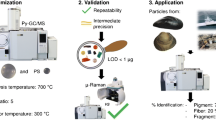Abstract
Monitoring of marine mammal steroid hormone status using matrices alternative to blood is desirable due to the ability to remotely collect samples, which minimizes stress to the animal. However, measurement techniques in alternative matrices such as blubber described to date are limited in the number and types of hormones measured. Therefore, a new method using bead homogenization to QuEChERS (Quick, Easy, Cheap, Effective, Rugged, and Safe) extraction, C18 post extraction cleanup and analysis by liquid chromatography tandem mass spectrometry (LC-MS/MS) was developed and applied to the measurement of hormone suites in bottlenose dolphin blubber. Validations were conducted in blubber from fresh dead stranded bottlenose dolphin. The final method consisting of two LC separations and garnet bead homogenization was tested for extraction efficiencies. Steroids were separated using a biphenyl column for reproductive hormones and C18 column for corticosteroids. Three hormones previously noted in blubber, testosterone, progesterone, and cortisol, were quantified in addition to previously unmeasured androstenedione, 17-hydroxyprogesterone, 11-deoxycortisol, 11-deoxycorticosterone, and cortisone in a single sample (0.4 g blubber). Extraction efficiencies of all hormones from blubber ranged from 84% to 112% and all RSDs were comparable to those reported using immunoassay methods (< 15%). The method was successfully applied to remote biopsied blubber samples to measure baseline hormone concentrations. Through this method, increased coverage of steroid hormone pathways from a single remotely collected sample potentially enhances the ability to interpret biological phenomena such as reproduction and stress in wild dolphin populations.

The steroid hormone profile is quantifiable from a single sample of bottlenose dolphin blubber using liquid chromatography tandem mass spectrometry. This profile can be applied to remotely collected dart biopsies and be used to determine reproductive or stress status of a wild-living dolphin.



Similar content being viewed by others
References
Tanabe S. Contamination and toxic effects of persistent endocrine disrupters in marine mammals and birds. Mar Pollut Bull. 2002;45(1–12):69–77. doi:10.1016/s0025-326x(02)00175-3.
Hoekstra PF, Dehn LA, George JC, Solomon KR, Muir DCG, O'Hara TM. Trophic ecology of bowhead whales (Balaena mysticetus) compared with that of other arctic marine biota as interpreted from carbon-, nitrogen-, and sulfur-isotope signatures. Can J Zool-Rev Can Zool. 2002;80(2):223–31. doi:10.1139/z01-229.
Schwacke LH, Gulland FM, White S. Sentinel species in oceans and human health. In: Laws EA, editor. Environmental toxicology: selected entries from the encyclopedia of sustainability Science and technology. New York: Springer; 2013. p. 503–28.
Stephens MAC, Mahon PB, McCaul ME, Wand GS. Hypothalamic-pituitary-adrenal axis response to acute psychosocial stress: effects of biological sex and circulating sex hormones. Psychoneuroendocrinology. 2016;66:47–55. doi:10.1016/j.psyneuen.2015.12.021.
Mastorakos G, Pavlatou MG, Mizamtsidi M. The hypothalamic-pituitary-adrenal and the hypothalamic- pituitary-gonadal axes interplay. Pediatr Endocrinol Rev. 2006;3(Suppl 1):172–81.
Atkinson S, Crocker D, Houser D, Mashburn K. Stress physiology in marine mammals: how well do they fit the terrestrial model? J Comp Physiol B: Biocem Syst Environ. 2015;185(5):463–86.
Krutzen M, Barre LM, Moller LM, Heithaus MR, Simms C, Sherwin WB. A biopsy system for small cetaceans: darting success and wound healing in Tursiops SPP. Mar Mamm Sci. 2002;18(4):863–78. doi:10.1111/j.1748-7692.2002.tb01078.x.
Kellar NM, Trego ML, Marks CI, Chivers SJ, Danil K, Archer FI. Blubber testosterone: a potential marker of male reproductive status in short-beaked common dolphins. Mar Mamm Sci. 2009;25(3):507–22. doi:10.1111/j.1748-7692.2009.00291.x.
Kellar NM, Trego ML, Marks CI, Dizon AE. Determining pregnancy from blubber in three species of delphinids. Mar Mamm Sci. 2006;22(1):1–16.
Perez S, Garcia-Lopez A, De Stephanis R, Gimenez J, Garcia-Tiscar S, Verborgh P, et al. Use of blubber levels of progesterone to determine pregnancy in free-ranging live cetaceans. Mar Biol. 2011;158(7):1677–80. doi:10.1007/s00227-011-1676-9.
Trego ML, Kellar NM, Danil K. Validation of blubber progesterone concentrations for pregnancy determination in three dolphin species and a porpoise. PLoS One. 2013;8(7):1–9. doi:10.1371/journal.pone.0069709.
Kellar NM, Catelani KN, Robbins MN, Trego ML, Allen CD, Danil K, et al. Blubber cortisol: a potential tool for assessing stress response in free-ranging dolphins without effects due to sampling. PLoS One. 2015;10(2):16. doi:10.1371/journal.pone.0115257.
Champagne CD, Kellar NM, Crocker DE, Wasser SK, Booth RK, Trego ML, et al. Blubber cortisol qualitatively reflects circulating cortisol concentrations in bottlenose dolphins. Mar Mamm Sci. 2016;33(1):134–53. doi:10.1111/mms.12352.
Fanelli F, Belluomo I, Di Lallo VD, Cuomo G, De Iasio R, Baccini M, et al. Serum steroid profiling by isotopic dilution-liquid chromatography-mass spectrometry: comparison with current immunoassays and reference intervals in healthy adults. Steroids. 2011;76(3):244–53. doi:10.1016/j.steroids.2010.11.005.
Stanczyk FZ, Clarke NJ. Advantages and challenges of mass spectrometry assays for steroid hormones. J Steroid Biochem Mol Biol. 2010;121(3–5):491–5. doi:10.1016/j.jsbmb.2010.05.001.
Bechshoft T, Wright AJ, Weisser JJ, Teilmann J, Dietz R, Hansen M, et al. Developing a new research tool for use in free-ranging cetaceans: recovering cortisol from harbour porpoise skin. Conserv Physiol. 2015;3:9. doi:10.1093/conphys/cov016.
Hogg CJ, Vickers ER, Rogers TL. Determination of testosterone in saliva and blow of bottlenose dolphins (Tursiops truncatus) using liquid chromatography–mass spectrometry. J Chromatogr B. 2005;814(2):339–46. doi:10.1016/j.jchromb.2004.10.058.
Hogg CJ, Rogers TL, Shorter A, Barton K, Miller PJO, Nowacek D. Determination of steroid hormones in whale blow: it is possible. Mar Mamm Sci. 2009;25(3):605–18. doi:10.1111/j.1748-7692.2008.00277.x.
Litz JA, Garrison LP, Fieber LA, Martinez A, Contillo JP, Kucklick JR. Fine-scale spatial variation of persistent organic pollutants in bottlenose dolphins (Tursiops truncatus) in Biscayne Bay. Florida Environ Sci Technol. 2007;41(21):7222–8.
Fu R, Zhai A. Determination of Hormones in Shrimp by Agilent 1290 Infinity LC with Agilent Poroshell 120 LC Column and Agilent Bond Elut QuEChERS for Sample Preparation. In: Technologies A, editor. Application note. http://www.chem.agilent.com/Library/applications/5990-6589EN.pdf. Agilent Technologies; 2012.
Boggs ASP, Bowden JA, Galligan TM, Guillette LJ, Kucklick JR. Development of a multi-class steroid hormone screening method using liquid chromatography/tandem mass spectrometry (LC-MS/MS). Anal Bioanal Chem. 2016;408(15):4179–90. doi:10.1007/s00216-016-9512-1.
Tai SS, Welch MJ. Development and evaluation of a candidate reference method for the determination of total cortisol in human serum using isotope dilution liquid chromatography/mass spectrometry and liquid chromatography/tandem mass spectrometry. Anal Chem. 2004;76(4):1008–14. doi:10.1021/ac034966f.
Ragland JM, Liebert D, Wirth E. Using procedural blanks to generate analyte-specific limits of detection for persistent organic pollutants based on GC-MS analysis. Anal Chem. 2014;86(15):7696–704. doi:10.1021/ac501615n.
Kershaw JL, Hall AJ. Seasonal variation in harbour seal (Phoca vitulina) blubber cortisol - a novel indicator of physiological state? Sci Rep. 2016;6:21889. doi:10.1038/srep21889.
Li J, Papadopoulos V, Vihma V. Steroid biosynthesis in adipose tissue. Steroids. 2015;103:89–104. doi:10.1016/j.steroids.2015.03.016.
Begumhasan J, Murphy BEP. Invitro stimulation of placental progesterone production by 19-nortestostereone and C-19 steroids in early human-pregnancy. J Clin Endocrinol Metab. 1992;75(3):838–45. doi:10.1210/jc.75.3.838.
Legacki EL, Scholtz EL, Ball BA, Stanley SD, Berger T, Conley AJ. The dynamic steroid landscape of equine pregnancy mapped by mass spectrometry. Reproduction. 2016;151(4):421–30. doi:10.1530/rep-15-0547.
Castracane VD, Asch RH. Testosterone and androstenedione in premature ovarian failure pregnancies: evidence for an ovarian source of androgens in early-pregnancy. Hum Reprod. 1995;10(3):677–80.
Acknowledgements
We would like to thank Louis J. Guillette Jr. for being the uniting force that made this collaborative project possible. Also, we would like to thank those who contributed their hard work in the coordination and collection of these samples including the South Carolina Marine Mammal Stranding Network, Brian Balmer, and Eric Zolman. We thank Patricia Rosel from the National Marine Fisheries Service, Southeast Fisheries Science Center for genetic analysis of the dart biopsies for sex determination. This research was made possible through a grant from the Office of Naval Research Marine Mammals and Biology Program and additional funding was provided by the National Institute of Standards and Technology, the National Oceanic and Atmospheric Administration, Marine Mammal Health and Stranding Response Program, and the National Academies National Research Council Research Associateship Program for a postdoctoral fellowship from 2013 to 2015.
Author information
Authors and Affiliations
Corresponding author
Ethics declarations
All research protocols used were approved by a NOAA Institutional Animal Care and Use Committee. Collections were conducted in an ethical manner in concordance with ethical standard guidelines provided by the Office of Protected Resources, Marine Mammal Health and Stranding Response Program and Animal Welfare Act and under the NOAA authorization 109(h) of the Marine Mammal Protection Act.
This research was partially funded by the Office of Naval Research (ONR) under grant award numbers N0001412IP20053, N0001411IP20085, and N000141110542. The authors declare that they have no conflict of interest in the publication of this manuscript. Commercial equipment, instruments, or materials are identified to specify adequately the experimental procedure. Such identification does not imply recommendation or endorsement by the National Institute of Standards and Technology nor the National Oceanographic and Atmospheric Administration, nor does it imply that the materials or equipment identified are necessarily the best available for the purpose.
Electronic supplementary material
ESM 1
(PDF 112 kb)
Rights and permissions
About this article
Cite this article
Boggs, A.S.P., Schock, T.B., Schwacke, L.H. et al. Rapid and reliable steroid hormone profiling in Tursiops truncatus blubber using liquid chromatography tandem mass spectrometry (LC-MS/MS). Anal Bioanal Chem 409, 5019–5029 (2017). https://doi.org/10.1007/s00216-017-0446-z
Received:
Revised:
Accepted:
Published:
Issue Date:
DOI: https://doi.org/10.1007/s00216-017-0446-z




